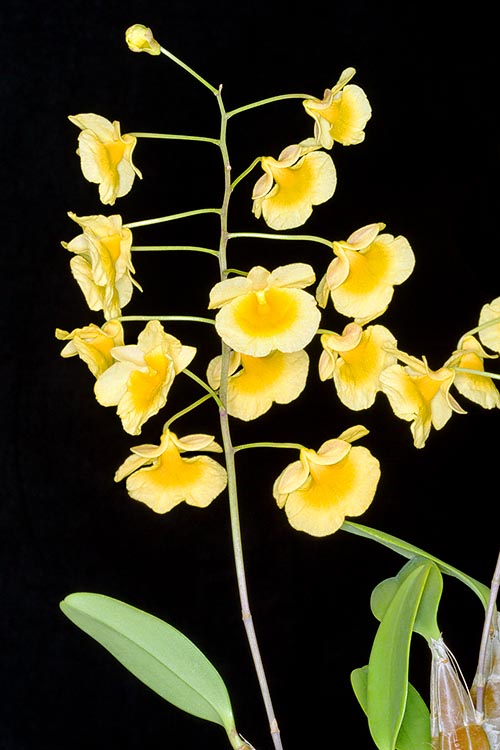Family : Orchidaceae

Text © Pietro Puccio

English translation by Mario Beltramini

Dendrobium lindleyi is a small epiphyte of South-East Asia deciduous forests. The inflorescence, racemose subterminal often drooping, lasts 2-3 weeks © Giuseppe Mazza
The name of the genus is the combination of the Greek substantives “δένδρον” (dendron) = tree and “βίος” (bios) = life, with reference to the numerous species of the genus living on the trees; the species is honoured to the English botanist John Lindley (1799-1865).
Common names: jus hi hu (Chinese); ueang phung (Thai).
The Dendrobium lindleyi Steud. (1840) is an epiphytic species with close together fusiform pseudobulbs thinned at the base, grooved, 3-8 cm long and of 1-2 cm of diameter, with at the apex usually one single persistent oblong leaf with obtuse apex, 4-12 cm long and 1-3 cm broad, coriaceous, thick, of intense green colour. Subterminal racemose inflorescence usually drooping, 10-30 cm long, carrying 5-20 delicate flowers, slightly scented, of 2,5-3 cm of diameter, light yellow to golden yellow, opening almost at the same time. Ovate-lanceolate, up to 1,5 cm long and 0,5 cm broad sepal; the lateral ones, merged at the base of the column, form a sort of short spur (mentum). Obovate petals with pointed apex, about 1,5 cm long and 1 cm broad, slightly concave orbicular labellum with retuse apex and undulated and ciliate margins, about 2 cm long and 2,5 cm broad, pubescent and nuanced of orange yellow at the base.
It reproduces by seed, in vitro, and division, to be done by the vegetative restart, with section provided of at least 5-7 pseudobulbs.
Species of small dimensions with luminous and spectacular blooming lasting 2-3 weeks, easy to cultivate if are fully respected its exigencies of light, heat and humidity. During the growth of the pseudobulbs, from spring to autumn, it requires a slight shade, medium-high temperatures, high humidity, 80-85%, regular and abundant waterings, but leaving to dry up before giving water again. In autumn the waterings are to be gradually reduced till the complete suspension in winter, in this period the luminosity must be at the maximum, also some hours of direct sun, the night temperatures must be within 9 and 14 °C, upper values may inhibit the blooming, the humidity around the 60-65% and the fertilizations stopped, may be necessary sporadic nebulisations if the pseudobulbs wrinkle too much. When the bloomings appear, by late winter-early spring, the waterings are to be gradually increased until the normal water regime is reached by the vegetative restart; for the waterings and nebulisations is to be used rain water, from reverse osmosis or demineralised. Fundamental is, in all seasons, constant ventilation.
It can be mounted on bark, trunks, rafts of cork or of arborescent ferns roots, or cultivated in small pots or baskets with particularly draining and aerated compost, that may be formed by medium sliced bark and charcoal fragments with possible addition of inerts for improving the drainage. Transplants and repotting are to be done when strictly necessary, as it does not love to be disturbed, by the vegetative restart, signalled by the appearance of the new roots.
The species is reported in the appendix II of the CITES (species whose trade is internationally ruled).
Synonyms: Dendrobium aggregatum Roxb. (1832); Epidendrum aggregatum Roxb. ex Steud. (1840); Callista aggregata Kuntze (1891); Callista aggregata (Roxb.) Brieger (1981).
→ For general notions about ORCHIDACEAE please click here.
